![]()
Aroids and other genera in the Collection
Take the Tour Now?
Orchids
The
Exotic Rainforest
Plants in
the Exotic Rainforest Collection
Images on this website are copyright protected. Contact us before attempting to reuse.
In depth information on how to grow Philodendron species, Click this Link
Within our collection we have many species of Philodendron. If you are seeking other photos, click this link
Philodendron
melinonii
Brongn.
ex Regel
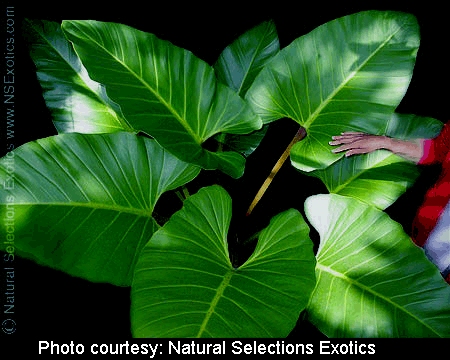
Quite often Philodendron species just don't match the "expected" description of the genus. If you read many of the posts on various garden websites you'll find numerous discussions which will lead you to believe all Philodendron sp. are small vines which trail out of a pot on a kitchen or bathroom counter. Sorry, but this one won't fit!
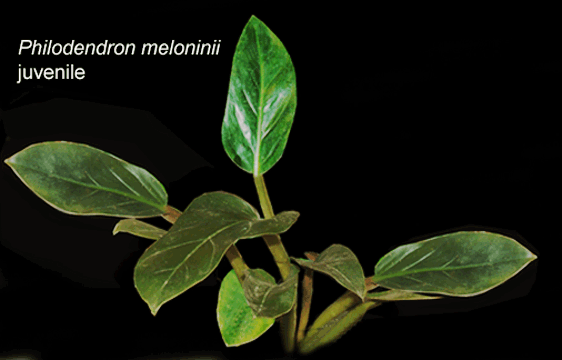 at the
left and in the photo below right). Information regarding the
name on the tag, Philodendron melinonii (mel-i-no-NEE-eye), was sparse! I found a
total of two small paragraphs in one of Dr. Tom Croat's journals.
Almost nothing else. I was able to learn P. melinonii was
found in the rain forests of French Guiana, Suriname, Venezuela, and
Northern Brazil. And, according to TROPICOS which is a service of the
Missouri Botanical Garden, the plant was identified to science in 1874.
So it has been known to scientists for a long time. But apparently,
collectors have not picked up the species as a commonly collected specimen.
Although our specimen is still quite small, from personal observation,
it is also apparent the leaf blades will be heavily coriaceous (leathery)
when grown.
at the
left and in the photo below right). Information regarding the
name on the tag, Philodendron melinonii (mel-i-no-NEE-eye), was sparse! I found a
total of two small paragraphs in one of Dr. Tom Croat's journals.
Almost nothing else. I was able to learn P. melinonii was
found in the rain forests of French Guiana, Suriname, Venezuela, and
Northern Brazil. And, according to TROPICOS which is a service of the
Missouri Botanical Garden, the plant was identified to science in 1874.
So it has been known to scientists for a long time. But apparently,
collectors have not picked up the species as a commonly collected specimen.
Although our specimen is still quite small, from personal observation,
it is also apparent the leaf blades will be heavily coriaceous (leathery)
when grown.Philodendron melinonii is both terrestrial and epiphytic. An epiphytic species is one capable of growing on the branch of a tree or climbing a tree in to better collect sunlight. In nature the species Philodendron melinonii is found growing high in the canopy perched out on the limb of a tree. The undersides of the juvenile leaf blades of the species were reddish in color which morph into a matte green as the species matures. Dr. Croat pointed out in one of his notes, "Philodendron melinonii Brongn. ex Regel, a distinctive species with cordate blades and placed by Krause in P. sect. Macrolonchium, is in my opinion, not related to either of the sections with lobed leaves." A cordate blade is one that is more or less "heart shaped".
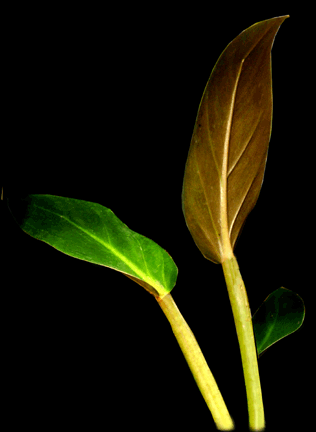 Since the Philodendron species is
epiphytic, but also grows as a terrestrial plant, the question arose
"just how large will this Philodendron grow". How large would
our small specimen eventually become? I set out to gather information
from a group of collectors and researchers who are often a great source
of information on any almost aroid species, the people who contribute information and
discuss aroid species on Aroid l (that's an L). This plant can
become very large!
Since the Philodendron species is
epiphytic, but also grows as a terrestrial plant, the question arose
"just how large will this Philodendron grow". How large would
our small specimen eventually become? I set out to gather information
from a group of collectors and researchers who are often a great source
of information on any almost aroid species, the people who contribute information and
discuss aroid species on Aroid l (that's an L). This plant can
become very large! At approximately the same time as
Jonathan responded, I received a note from noted aroid collector and
author Leland Miyano in Hawaii. Leland worked closely with highly
respected Brazilian plant collector, author and artist Roberto Burle Marx
(now deceased).
Leland commented, "I
grow a good number of these
plants
and the following will give you a better idea
of the appearance and my
cultural practices. Philodendron melinonii is common in the Manaus
area of Brazil....Roberto had several expeditions to the Amazon and my
plants are from his collections. I have seen slight variations
regarding the color of the petioles, but am unsure if this is a genetic
or cultural trait in all instances. I have the typical reddish petiole
form but in shade, these will be green. Regarding ultimate
size, my plants have petioles about 28 inches long. The leaf blades are
also about 28 inches long
by about 20 inches
wide. A large plant can be about 8 feet in diameter...larger if a
cluster of plants is grown as they pup regularly in bright light.
At approximately the same time as
Jonathan responded, I received a note from noted aroid collector and
author Leland Miyano in Hawaii. Leland worked closely with highly
respected Brazilian plant collector, author and artist Roberto Burle Marx
(now deceased).
Leland commented, "I
grow a good number of these
plants
and the following will give you a better idea
of the appearance and my
cultural practices. Philodendron melinonii is common in the Manaus
area of Brazil....Roberto had several expeditions to the Amazon and my
plants are from his collections. I have seen slight variations
regarding the color of the petioles, but am unsure if this is a genetic
or cultural trait in all instances. I have the typical reddish petiole
form but in shade, these will be green. Regarding ultimate
size, my plants have petioles about 28 inches long. The leaf blades are
also about 28 inches long
by about 20 inches
wide. A large plant can be about 8 feet in diameter...larger if a
cluster of plants is grown as they pup regularly in bright light.
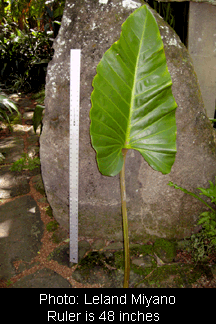 I grow them as both
epiphytes and terrestrials, although the normal condition in habitat is
as epiphytes. The stems are covered with a dense fiber, and to separate
pups is usually best
done
while the plants are small...one must dig down through this fiber to
find the point of origin of the pups. Culturally, this plant is easy as
long as the light levels are not too low. Large plants can easily weigh
75 pounds or more, but the rosettes are compact and the plants are well
worth the space. Growth rate is moderate in strong, but not burning
sun. The petioles get a deeper color as the light levels increase."
I grow them as both
epiphytes and terrestrials, although the normal condition in habitat is
as epiphytes. The stems are covered with a dense fiber, and to separate
pups is usually best
done
while the plants are small...one must dig down through this fiber to
find the point of origin of the pups. Culturally, this plant is easy as
long as the light levels are not too low. Large plants can easily weigh
75 pounds or more, but the rosettes are compact and the plants are well
worth the space. Growth rate is moderate in strong, but not burning
sun. The petioles get a deeper color as the light levels increase."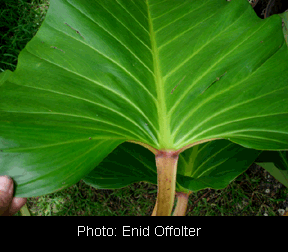 Leland and Ron, a fully grown specimen can reach approximately eight feet in diameter
(2.5 meters). And remember, this spectacular Philodendron commonly grows up on the branch of a rain
forest tree!
Leland and Ron, a fully grown specimen can reach approximately eight feet in diameter
(2.5 meters). And remember, this spectacular Philodendron commonly grows up on the branch of a rain
forest tree! 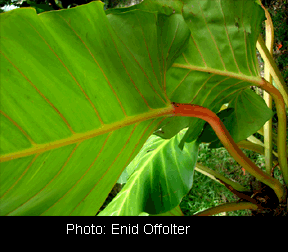 and if cut
the cross section could be observed to be
shaped like a capital letter "D" or sunken on the upper
surface to resemble the capital letter "C". Despite common
misconceptions, the petiole is not the "stem" which is the term commonly
incorrectly used by collectors. The petiole is the stalk which connects
the leaf blade to the stem which is at the base of the plant. The
C shape is described by a botanist as being sulcate. The term
sulcate may indicate either a single channel running down the axis of
the petiole or a series of tiny parallel groves running down the axis. The petioles are near equal size
to the leaf blade as can be observed in Leland's photos.
and if cut
the cross section could be observed to be
shaped like a capital letter "D" or sunken on the upper
surface to resemble the capital letter "C". Despite common
misconceptions, the petiole is not the "stem" which is the term commonly
incorrectly used by collectors. The petiole is the stalk which connects
the leaf blade to the stem which is at the base of the plant. The
C shape is described by a botanist as being sulcate. The term
sulcate may indicate either a single channel running down the axis of
the petiole or a series of tiny parallel groves running down the axis. The petioles are near equal size
to the leaf blade as can be observed in Leland's photos. When a new petiole grows from a node it is surrounded by a cataphyll which is a bract-like modified leaf that surrounds and protects the new leaf as it develops. A cataphyll is any foliar organ that has no differentiation between the petiole and the blade. The cataphyll is the singular most important identifying characteristic of an aroid due to its very unique shape. Once the cataphylls of Philodendron melinonii dry they remain on the plant as persistent fibers.
All Philodendron species are members of the larger plant family known as Araceae, commonly called aroids. An aroid is a plant that reproduces via the production of an inflorescence which in aroids is known to science as a spathe and spadix. Some believe the spathe is a "flower" which is incorrect. The spathe is simply a modified leaf appearing to be appear as a hood and is sometimes shaped like a tube. When an aroid is referred to as "flowering" the reference is to the very small flowers found on the spadix and has nothing to do with the spathe. Within the inflorescence there are extremely small flowers found on the spadix during anthesis (sexual reproduction). The spadix is found at the center of the inflorescence. When ready to reproduce, the spadix produces both male, female and sterile flowers and if the female flowers are pollinated with pollen brought by an appropriate insect (normally a beetle) from another plant which is at male anthesis they will produce berries containing seeds. The female flowers are hidden from view inside the floral chamber at the bottom of the spathe in Philodendron species. Due to natural variation within the species Philodendron melinonii the spathe tube is white on the inside but may be greenish aging to reddish on the exterior of the spathe tube.
Typically, the seeds of epiphytic species are distributed by birds or rain forest animals that eat the berries containing seeds produced on a pollinated spadix. In the case of Philodendron melinonii, Joep indicated in a recent email, insects also contribute to the species' distribution. Joep wrote he had observed photographs of, "ants carrying the seeds of Philodendron melinonii away near Saut Mapao on the Approuague river in French Guiana". He commented further regarding the species in an email to Julius Boos, "Philodendron melinonii is a real epiphyte. The seed is likely dropped at a branch or tree trunk and develops right there to adult plants. Fat petioles (some times red in color), yellowish fruits that are carried away by ants." Regardless of how it gets from from tree to tree in the wild, Philodendron melinonii is going to make one fabulous centerpiece in the collection once it matures.
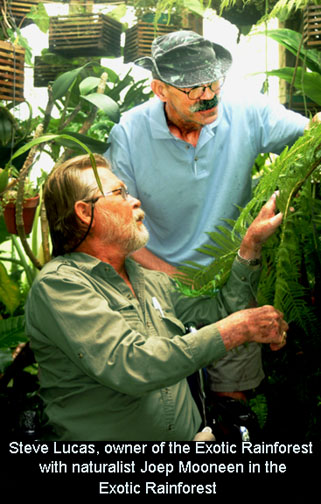 My thanks to Enid Offolter of Natural
Selections Exotics in Fort Lauderdale for the use of her photo as well
as those of Leland Miyano and Brian Williams. Much thanks to all
those who responded with valuable information via Aroid l. Others
also responded with photos and I regret space prevents the use of all
that were provided. And my sincere thanks to my friend Joep Moonen who provided the
specimen.
My thanks to Enid Offolter of Natural
Selections Exotics in Fort Lauderdale for the use of her photo as well
as those of Leland Miyano and Brian Williams. Much thanks to all
those who responded with valuable information via Aroid l. Others
also responded with photos and I regret space prevents the use of all
that were provided. And my sincere thanks to my friend Joep Moonen who provided the
specimen.Click here.
If you would enjoy spending time with an extremely knowledgeable expert guide in a rain forest filled with exotic creatures and extremely rare exotic plant species, Joep Moonen (pronounced yupe) also enjoys introducing people like you to the rain forests of northeast South America. The Emerald Jungle Village website can be found at: http://home.planet.nl/~gumamaus/ For eco-tour information and a brochure contact Joep Moonen (pronounced yupe) directly at EmeraldJungleVillage@wanadoo.fr
Looking for a specimen? Contact
http:///
![]()
Out of print copies of Aroideana can often be ordered directly from the International Aroid Society: http://www.aroid.org/
Want to learn more
about aroids?
Join the
International Aroid Society:
http://www.exoticrainforest.com/Join%20IAS.html
If you are seeking information on other rare
species, click on "Aroids and other genera in the Collection" at the top of
the page and look for
the